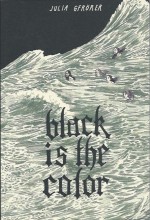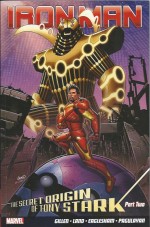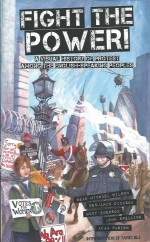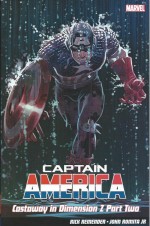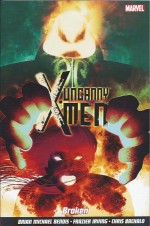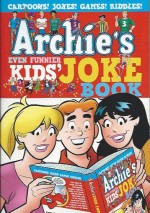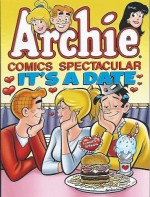
By Archie Superstars (Archie Comics)
ISBN: 978-1-936975-70-9
Win’s Christmas Gift Recommendation: Another amazing example of pure comicbook magic… 9/10
Since comicbooks were invented in 1933, Superheroes have become the genre most closely associated with the four-colour format. Nevertheless other forms of sequentially illustrated fiction have held their own periodically and the one which has maintained a unique position over the years (although almost completely abandoned by most publishers and picked up by television) is the teen-comedy genre begun by and still synonymous with a ginger-headed freckled lad named Archie Andrews.
He began his rise to glory when second-string publisher MLJ added a strip based on the Andy Hardy matinee movies to the line-up of costumed mystery men they’d created after Superman debuted in Action Comics #1 in 1938.
In 1939 MLJ launched Blue Ribbon Comics, Top-Notch and Pep Comics filled with the now mandatory blend of masked heroes, two-fisted adventurers strips and one-off gags. Pep actually made a little history with its lead feature The Shield – the USA’s first superhero draped in the American flag – but generally MLJ were followers not innovators.
That changed at the end of 1941 when Maurice Coyne, Louis Silberkleit and John Goldwater (MLJ, geddit?) spotted a gap in their blossoming market. In December their Fights ‘n’ Tights pantheon was extended to include a wholesome, hometown hero: an “average teen†whose invitingly human-scaled adventures might happen to any of the readers, but with the laughs, good times, romance and slapstick heavily emphasised.
Pep Comics #22 introduced the gap-toothed, red-headed goof, already showing off to the pretty blonde next door. Goldwater had developed the concept of a boyish everyman, and left writer Vic Bloom & artist Bob Montana alone to fill in the details and make it all work it work.
And it did. So effective and all-pervasive was the impact and reassuring message which the new kid offered to the boys “over there†and those scared folk left behind on the Home Front that Archie and his familiar, beloved, secure milieu immortalised in Riverdale and its inhabitants gang represented, that one might consider them the most effective Patriotic Propaganda weapon in comics history…
It all started with an innocuous 6-pager introducing Archie, cute girl-next-door Betty Cooper, the boy’s quirky best friend and confidante Forsythe P. “Jughead†Jones and the small-town utopia they lived in.
The premise was an instant hit and in 1942 Archie graduated to his own title. Archie Comics #1 was MLJ’s first non-anthology magazine and began the inexorable transformation of the company. With the introduction of rich, raven-haired Veronica Lodge all the pieces were in play for the industry’s second Landmark Phenomenon (after Superman).
By May 1946 the kids had taken over. MLJ became Archie Comics, benching its costumed heroes years before the Golden Age ended and becoming to all intents and purposes a publisher of family comedies. This overwhelming success, just like the Man of Steel’s, compelled a change in the content of every other publisher’s titles and was the genesis of a multi-media industry which included toys, games, merchandise, newspaper strips, TV shows, movies, pop-songs and even a chain of restaurants.
Why does it work? Archie is a splendidly ordinary, good-hearted kid, not too smart, a bit impulsive and unthinking and generally lacking common sense – just like we were – whilst Betty – pretty, sensible, capable and devoted is the quintessential Girl Next Door, with everything that entails.
She loves the ridiculous redhead but is also best friends with her own great rival. Ronnie is spoiled, exotic, quixotic and glamorous but seemingly only settles for our boy if there’s nobody better around… except she might actually love him too…
Archie just can’t decide who or what he wants. Even with these two alluring archetypes always around he still gets distracted every time a pretty new girl sashays past…
This engaging and never-tawdry eternal triangle has been the solid basis of more than seventy years of charmingly raucous, gently preposterous, frenetic, chiding and even heart-rending comedy, encompassing everything from surreal wit to frantic slapstick, as the kids and an ever-increasing cast of friends grew into an American institution.
Adapting seamlessly to every trend and fad, perfectly in tone with and mirroring the growth of teen culture, the host of writers and artists who’ve crafted the stories over the decades have made the denizens of Riverdale a benchmark for youth and a visual barometer of growing up American.
The unconventional Jughead is Mercutio to Archie’s Romeo, generally providing rationality and a reader’s voice, as well as being a powerful and mischievous catalyst of events in his own right. There’s even a likeably reprehensible Tybalt analogue in the cocky crafty shape of Reggie Mantle – who first popped up to cause mischief in Jackpot Comics #5 (Spring 1942) – to act as spur, foil and rival and keep the tension ticking over.
This beguiling triangle (plus annexe and outhouse) has been the rock-solid foundation for decades of comics magic and even though the concept is perpetually self-renewing, Archie has thrived by constantly reinventing and refining these core characters, adapting them to the changing world outside the bright, flimsy pages and shamelessly co-opting youth, pop culture, sport, gadgets and fashion trends into its infallible mix of slapstick and young romance.
Each and every social revolution has been painlessly assimilated into the mix with the editors tastefully confronting a number of social issues affecting the young in a manner both even-handed and tasteful over the years.
Most importantly, the quotidian supporting cast – from affable jock Moose to plain Jane Big Ethel or boy genius Dilton Doily, School Principal Mr. Weatherbee or Ronnie’s irascible dad – is always expanding, with constant addition of new characters such as African-American aspiring cartoonist Chuck and his girlfriend Nancy, fashion-diva Ginger, Hispanic couple Frankie & Maria and a host of others.
There are frequent new additions in the opposition too, like spoiled home-wrecker-in-waiting Cheryl Blossom, all contributing to the wide and surprisingly broad-minded scenario.
In 2010 Archie even jumped the final social repressive hurdle when Kevin Keller, an openly gay young man and clear-headed advocate, joined the cast, capably tackling and dismantling the last major taboo in mainstream comics.
Of course the major component of the company’s success has always been the superbly enticing artwork and charming, funny stories by a small army of creative superstars, and this digest-sized spectacular gathers a treasure trove of their very best efforts into a romantically-themed collection which teasingly opens with ‘The Big Decision’ by Barbara Slate, Tim Kennedy & Jon D’Agostino, wherein the red-headed rascal finally chooses his eventual life-mate… for about three seconds…
Betty & Veronica then star in ‘Foot Sore’ (George Gladir, Dan DeCarlo Jr. & Jimmy DeCarlo) as the girlish slaves to fashion lose out to primitive male obduracy after which ‘Root of All Evil’ by Frank Doyle and the astounding Harry Lucey finds Archie desperate to prove Ronnie’s money means nothing to him…
In ‘Muscle Main Man’ (Jim Pellowski, Dan Parent &Jim Amash) the Lodges find that inept Archie is not the worst boyfriend Veronica might pick, whilst in ‘Suspicion’ (Jim Ruth, Chic Stone & D’Agostino) the green-eyed monster drives our hero to make an especially big fool of himself before ‘Inflation Elation’ (Gladir, Bob Bolling & Bob Smith) sees Betty turn the boy’s pennypinching ways to her advantage…
Betty & Veronica take the spotlight in ‘Three’s A Crowd’ (Kathleen Webb, Parent & Rich Koslowski) when one of them horns in on the other’s date night, whilst in ‘Match Play’ (Gladir, Jeff Shultz & Al Milgrom) a computer-dating service proves no help when faced with Ronnie’s picky criteria…
The Lodge lass’s callous nature deposits her at the base of ‘The Infernal Triangle’ (Frank Doyle, Dan DeCarlo & Vince DeCarlo) when she tries to meddle with Betty’s love-life after which Ronnie finds a new beau in ‘By George!’ (Dan DeCarlo & Rudy Lapick). although they soon make-up – sort of – enough to try the dubious tactic of a ‘Dress Down Date’ (Doyle, Dan DeCarlo & Lapick) on cash-poor Betty…
Webb, Bolling & Lapick then detail Ronnie’s very temporary bout of maturity (i.e. sharing) in ‘Growing Pains’, after which ‘Well Placed Point’ – a fifties classic by Bill Vigoda – sees Archie give in to a challenge from Reggie which inevitably draws the wrath of Ronnie down upon his dim ginger head and ‘Chivalrous Chumps’ (John Albano, Dan DeCarlo Jr. & James DeCarlo) finds both laddish rivals’ heads simultaneously turned by some new girls in town…
A formal event allows Reg an opportunity to palm Arch off with a Magician’s rigged tuxedo in ‘Borrowed Trouble’ by Pellowski, Bolling & Smith, after which ‘Fun Daze Together’ (Webb, Doug Crane & Lapick) provides a rare chance for Betty to get her guy, before a garbled phone message taken by Archie’s dad leads to a happy outcome for someone in ‘Dial a Date’ (by Gladir & Stone).
‘Happy Days’ (Ruth & Stone) finds Archie and Betty frantically trying to save their old trysting tree whilst 2-part saga ‘The Search!’ (Parent & Amash) has Ronnie’s parents foolishly attempting to find far more suitable boyfriends – and living to regret it…
Lesser lights Big Moose and Midge star in ‘Don’t Be a Sport’ (Pellowski & Kennedy), learning to their surprise just what really keeps them together, whilst Chuck and Nancy almost split up in ‘Bowl Brummel’ (Gladir, Bolling & Lapick) after his slovenly attires enflame her ire…
To their bemused sorrow, Archie & the entire gang become embroiled in boy genius Dilton‘s ‘Rate-a-Mate’ (Parent & Koslowski) romance program before arrogant self-proclaimed gift to women Reggie tries his slickest moves on the wrong woman in ‘The Lawbreaker’ (Dick Malmgren) and the whole amorous kit and caboodle then culminates and closes with a brace of half-page howlers as ‘Betty in Up to Dates!’ and ‘Archie in Auto Know Better’ both reveal the pervasive appeal of Riverdale’s richest debutante…
Mesmerising, breathtaking graphic wonderment, fun-fuelled family entertainment and enticing pop art masterpieces; these comic confections always capture the joyous spirit of intoxicating youthful vitality which changed the comic industry forever and comprise an essential example of artistic excellence no lover of narrative art should miss.
© 2013 Archie Comics Publications, Inc. All rights reserved.
